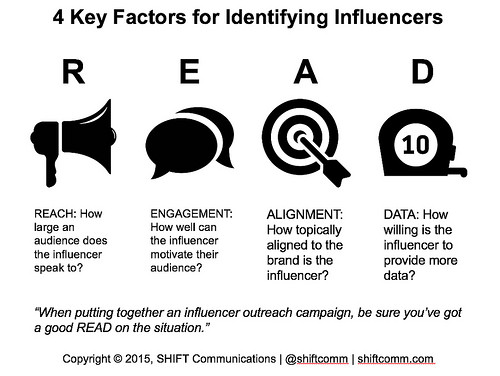Influencers is an incredibly nebulous term, yet it’s a focus for so many PR programs. Who is influential? What constitutes influence? While we could have lengthy philosophical debates about the nature of influence from Aristotle to today, such discussions tend not to give us operational frameworks for getting work done.
Compounding our confusion about who is influential are endless lists of the Top 50 influencers in X or Top 25 influencers in Y, often chosen by arbitrary and opaque methods. It’s risky to rely on someone else’s list, especially if you have no idea how they made it.
To shed some light on the topic, let’s explore a framework we use at SHIFT for identifying who is influential.
The READ framework is an acronym which stands for:
Reach. Influencers by their very nature tend to have larger reach. Some influence algorithms look at reach as a primary indicator of influence. Since we’re in the business of building audiences, reach is a good thing to have.
Engagement. Influencers don’t just collect passive eyeballs. Influencers can get audiences to do things, from sign petitions to buy products to stage mass protests. How much engagement does an influencer have?
Alignment. For marketers and PR professionals, alignment matters a great deal. An influencer in B2C consumer goods will have little sway and even less impact to an enterprise B2B SaaS company. Ensuring that influencers are topically aligned is a vital part of any influence program.
Data-Driven. The very best influencers work with brands, advertisers, communicators, and agencies to provide data back to their sponsors. Sometimes this is as simple as implementing additional Google Analytics tracking codes; sometimes this is as complex as lead co-registration or other data exchanges.
In terms of priority, alignment comes first. Very little else matters of the above structure if the influencer is a poor fit for your audience and your brand is a poor fit for their audience. Your search for influencers must begin with topical alignment.
Once you’ve established alignment, decide whether reach or engagement is more important to your campaign. Which you choose will determine the tools and tactics you use. Some tools such as Klout tend to weight reach more heavily in their influence algorithms. Other tools such as FollowerWonk tend to weight engagement more heavily in their algorithms.
Finally, when you kick off your influencer program, use as much data collection and tracking as you possibly can. Simple tactics such as providing pre-made bit.ly links (with click tracking turned on) to complex tactics like working with an influencer to co-deploy Google Tag Manager tags on your specific part of the campaign are essential to measuring the true impact of your influencer campaign.
Let’s look at an example of how this might work. Suppose, harkening back to one of our many April Fools’ jokes, we represented Todd and Jim’s Coffee Shop and we wanted to determine who was influential about the topic of coffee in the San Francisco Bay Area. We begin by searching for people who use jargon specific to coffee, industry jargon. These would include the various roast grades like “City+” and “Full City”, terms that the general public wouldn’t necessarily use, but connoisseurs would.
From here, we’d append either an engagement score or a reach score, depending on what tool we initially selected, so that we’d get both sets of data. Once we had reach and engagement data gathered, we’d create a weighted average between the two:
Finally, we verify both alignment and data of the top influencers we want to reach out to, by looking at their recent social shares:
This particular influencer appears to be on target, and they use a link sharing package that provides us with additional data. Let’s see what they share by lengthening their bit.ly* URLs:
Ouch. It looks like they ONLY share their own stuff, which means the likelihood of asking them to share content about Todd and Jim’s Coffee is fairly low. We can now disqualify this influencer and move onto the next one in our list.
Does this method of identifying influencers take more time than the common PR industry practice of just Googling for “top 50 influencers in X”? Yes, absolutely. But it’s a better, more targeted way of identifying influencers and it reduces the likelihood of bad pitching by only reaching out to people who have reach, engagement, alignment, and can provide data.
* Disclosure: bit.ly is a SHIFT client, but was not involved in the creation of this article. SHIFT receives no preferential treatment or special access to bit.ly’s APIs other than what is generally available in their developer program.
This article was syndicated from Business 2 Community: Getting a READ on Social Media Influencers
More Digital & Social articles from Business 2 Community:










